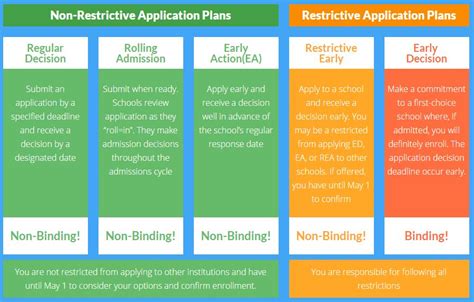Understanding Early Decision and Early Decision II
Early Decision (ED) and Early Decision II (ED2) are college admissions options that offer applicants the chance to receive an early decision on their application, typically before the regular decision deadline. Both options have their own timelines, benefits, and potential risks.

ED Timeline
- November 1: ED application deadline
- Mid-December: ED applicants notified of their decision
- May 1: ED candidates must submit a National Candidate Reply Form to confirm their enrollment
ED2 Timeline
- January 1: ED2 application deadline
- Mid-February: ED2 applicants notified of their decision
- May 1: ED2 candidates must submit a National Candidate Reply Form to confirm their enrollment
Benefits of ED and ED2
- Increased chances of admission: Studies have shown that applicants who apply ED or ED2 have a higher chance of admission than those who apply regular decision.
- Early notification of decision: ED and ED2 applicants receive their decision well before the regular decision deadline, giving them peace of mind and ample time to make plans.
- Priority consideration: ED and ED2 applicants are often given priority consideration in the admissions process, meaning their applications may be reviewed more carefully.
Considerations for ED and ED2
- Binding agreement: If admitted under ED or ED2, you are legally bound to attend that institution and withdraw any other applications.
- Limited number of schools: You can only apply to one institution under ED and one institution under ED2.
- Risk of rejection: While ED and ED2 increase your chances of admission, they do not guarantee it.
Comparing ED and ED2
| Feature | ED | ED2 |
|---|---|---|
| Application deadline | November 1 | January 1 |
| Notification of decision | Mid-December | Mid-February |
| Binding agreement | Yes | Yes |
| Number of schools eligible | 1 | 1 |
| Risk of rejection | Higher | Lower |
How to Decide if ED or ED2 is Right for You
Consider the following factors when deciding whether to apply ED or ED2:
- Your academic profile: Do you have a strong GPA and test scores? ED and ED2 can be advantageous if your credentials are competitive.
- Your dream school: Do you have a strong preference for a particular institution? ED or ED2 can increase your chances of getting into your top choice.
- Your risk tolerance: Are you comfortable with the binding agreement and the risk of rejection? If you are not, regular decision may be a better option.
Innovative Applications of ED and ED2
One innovative application of ED and ED2 is “ED-ED2 cycling.” This strategy involves applying to a less competitive school under ED and a more competitive school under ED2. If admitted to the less competitive school under ED, you can withdraw that application and apply to the more competitive school under ED2, increasing your chances of admission to the latter school.
Step-by-Step Approach to Applying ED or ED2
- Research and select a school: Identify institutions that offer ED or ED2 and that align with your academic interests and preferences.
- Review application requirements: Check the specific deadlines, criteria, and materials required for ED or ED2 applications.
- Prepare your application: Gather all necessary transcripts, test scores, essays, and letters of recommendation.
- Submit your application: Submit your ED or ED2 application by the designated deadline.
- Await decision: Monitor your application status and be prepared to receive notification of your decision.
Why Early Decision Matters
According to the National Association for College Admission Counseling (NACAC), over 400 colleges and universities offer ED or ED2 programs, and the acceptance rate for early decision applicants is typically higher than for regular decision applicants. For example, Stanford University reported a 14.9% acceptance rate for ED applicants in 2022, compared to a 4.3% acceptance rate for regular decision applicants.
Benefits of Early Decision
- Increased chances of admission: Studies have shown that applicants who apply ED or ED2 have a significantly higher chance of admission than those who apply regular decision.
- Early notification of decision: ED and ED2 applicants receive their decision well before the regular decision deadline, giving them peace of mind and ample time to make plans.
- Priority consideration: ED and ED2 applicants are often given priority consideration in the admissions process, meaning their applications may be reviewed more carefully.
- Financial aid benefits: Some institutions offer additional financial aid opportunities to admitted ED or ED2 applicants.
Considerations for Early Decision
- Binding agreement: If admitted under ED or ED2, you are legally bound to attend that institution and withdraw any other applications.
- Limited number of schools: You can only apply to one institution under ED and one institution under ED2.
- Risk of rejection: While ED and ED2 increase your chances of admission, they do not guarantee it.
How to Choose Between ED and ED2
The choice between ED and ED2 depends on your individual circumstances and preferences. Consider the following factors:
- Application deadline: ED has a November 1 deadline, while ED2 has a January 1 deadline.
- Notification of decision: ED applicants receive their decision in mid-December, while ED2 applicants receive their decision in mid-February.
- Binding agreement: Both ED and ED2 are binding agreements, meaning you are legally bound to attend the institution you are admitted to.
- Number of schools: You can only apply to one institution under ED and one institution under ED2.
- Risk of rejection: ED has a higher risk of rejection than ED2, but it also has a higher acceptance rate.
Innovative Applications of Early Decision
One innovative application of early decision is “ED-ED2 cycling.” This strategy involves applying to a less competitive school under ED and a more competitive school under ED2. If admitted to the less competitive school under ED, you can withdraw that application and apply to the more competitive school under ED2, increasing your chances of admission to the latter school.
Step-by-Step Approach to Applying Early Decision
- Research and select a school: Identify institutions that offer ED or ED2 programs and that align with your academic interests and preferences.
- Review application requirements: Check the specific deadlines, criteria, and materials required for ED or ED2 applications.
- Prepare your application: Gather all necessary transcripts, test scores, essays, and letters of recommendation.
- Submit your application: Submit your ED or ED2 application by the designated deadline.
- Await decision: Monitor your application status and be prepared to receive notification of your decision.
Tables:
| ED vs. ED2: A Comparison | Pros and Cons of ED | Pros and Cons of ED2 | Innovative Applications of ED and ED2 |
|---|---|---|---|
| Feature | ED | ED2 | ED-ED2 cycling |
| Application deadline | November 1 | January 1 | Less competitive school under ED, more competitive school under ED2 |
| Notification of decision | Mid-December | Mid-February | Increased chances of admission to more competitive school |
| Binding agreement | Yes | Yes | Binding agreement to both ED and ED2 schools |
| Number of schools eligible | 1 | 1 | N/A |
| Risk of rejection | Higher | Lower | N/A |
